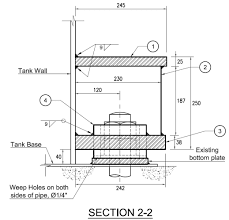Hey All -
I have a project where we have been asked to upgrade the anchorage for an existing steel surge tank at a hydroelectic plant. The existing steel anchors of the steel tank are inadequate to resist the uplift for the design event for seismic. The existing surge tank is more slender (close to 2:1 height to diameter ratio). The tank is built on a mass concrete foundation that extends about 2-feet from the outside radius of the tank. The concrete is founded on competent rock.
I wanted to get thoughts on our proposed approach. First we analyzed the tank following AWWA D100 to determine the overturning moment and then calculated the number of anchors and the required load resistance. I was thinking of extending the radius existing concrete founding and install DYWIDAG Thread bar anchors (number and diameter sized to resist load). The anchors would be drilled/grouted into the rock with adequate embedment to engage the rock mass needed to resist the load.
The tricky part is detailing the new anchor chairs. I am using AISI T-192 to design the anchor chairs. Due to the high load and eccentricity, the anchors chairs need to be pretty tall or the top plate needs to be wide to adequately reduce the stress concentrations in the shell. Right now we are trying to optimize this but I was thinking of just having the top plate as a continuous ring.
There are other details that we need to think through but just wanted to get thoughts on the overall approach or if anyone has had experience with upgrading tank anchors.
Thanks!
I have a project where we have been asked to upgrade the anchorage for an existing steel surge tank at a hydroelectic plant. The existing steel anchors of the steel tank are inadequate to resist the uplift for the design event for seismic. The existing surge tank is more slender (close to 2:1 height to diameter ratio). The tank is built on a mass concrete foundation that extends about 2-feet from the outside radius of the tank. The concrete is founded on competent rock.
I wanted to get thoughts on our proposed approach. First we analyzed the tank following AWWA D100 to determine the overturning moment and then calculated the number of anchors and the required load resistance. I was thinking of extending the radius existing concrete founding and install DYWIDAG Thread bar anchors (number and diameter sized to resist load). The anchors would be drilled/grouted into the rock with adequate embedment to engage the rock mass needed to resist the load.
The tricky part is detailing the new anchor chairs. I am using AISI T-192 to design the anchor chairs. Due to the high load and eccentricity, the anchors chairs need to be pretty tall or the top plate needs to be wide to adequately reduce the stress concentrations in the shell. Right now we are trying to optimize this but I was thinking of just having the top plate as a continuous ring.
There are other details that we need to think through but just wanted to get thoughts on the overall approach or if anyone has had experience with upgrading tank anchors.
Thanks!

